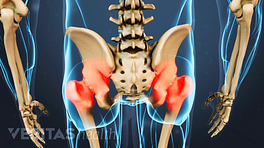Hip osteoarthritis is a condition where cartilage in the hip joint degenerates, leading to inflammation, pain, and loss of mobility in the hip joint.
Shaped like a ball and socket, the hip is a large joint that bears much of the body’s weight and makes activities like walking, running, and sitting possible.
In hip osteoarthritis, the cartilage that lines the acetabulum, or hip socket, and covers the ball-shaped femoral head becomes inflamed.
The inflamed cartilage degenerates over time, narrowing the space that normally exists between these two bones.
New cartilage may regrow, but the new cartilage is usually bumpy and irregular, creating joint friction.
Eventually, the cartilage may disappear completely, causing further friction of the acetabulum and femoral head during movement.
This bone-on-bone friction can also lead to the development of painful osteophytes, or bone spurs, in the hip joint.
Patients with hip osteoarthritis may feel a grating sensation during walking as the bones of the hip joint grind against one another.
Dull, achy pain from hip osteoarthritis is often felt in the groin and down the front of the thigh. This type of pain may also be felt in the buttock or lower back, and may be constant or intermittent.
Hip osteoarthritis can also cause brief episodes of sharp, stabbing pain in the hip.
As hip osteoarthritis progresses, patients can lose some or all of the hip’s range of motion.










